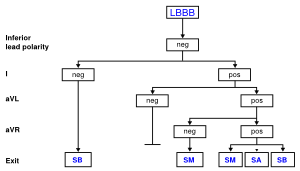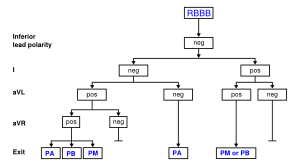Localisation of the origin of a ventricular tachycardia
The localisation of the origin (or exit site) of a ventricular tachycardia can be helpful in understanding the cause of the VT and is very helpful when planning an ablation procedure to treat a ventricular tachycardia.

Areas of the left ventricle where VT's can originate from: The left ventricle is depicted as having been opened. Regionsare as follows: AB: anterobasal; AM: mid anterior; AA anterior apex; SB: basal septum; SM, midseptum; SA, apical septum; PB: basal posterior; PM: mid posterior; PA: posterior apex. Adapted from Miller et al.[1]
Using this approach and the algorithm on the right [2] the exit site can be estimated with reasonable accuracy (PPV around 70%).
References
- Miller JM, Marchlinski FE, Buxton AE, and Josephson ME. Relationship between the 12-lead electrocardiogram during ventricular tachycardia and endocardial site of origin in patients with coronary artery disease. Circulation. 1988 Apr;77(4):759-66. DOI:10.1161/01.cir.77.4.759 |
- Segal OR, Chow AW, Wong T, Trevisi N, Lowe MD, Davies DW, Della Bella P, Packer DL, and Peters NS. A novel algorithm for determining endocardial VT exit site from 12-lead surface ECG characteristics in human, infarct-related ventricular tachycardia. J Cardiovasc Electrophysiol. 2007 Feb;18(2):161-8. DOI:10.1111/j.1540-8167.2007.00721.x |



